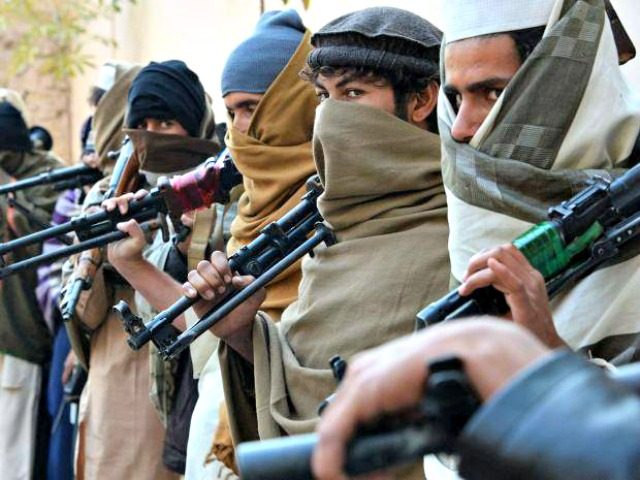Afghanistan’s national security adviser said Thursday in Washington that the number of foreign fighters flocking to Afghanistan is increasing — an alarming trend that could portend continued U.S. involvement in the war.
“Unfortunately, there has been a growth of foreign fighters,”Afghan National Security Adviser Mohammad Hanif Atmar said Thursday at the United States Institute of Peace.
“We’re talking about hundreds of them coming from the Middle East through Pakistan and other regional routes,” he said.
He named members of groups including Al Qaeda, the Islamic State, the Islamic Movement of Uzbekistan, the East Turkestan Islamic Movement, Lashkar-e-Taiba, Tehrik-e-Taliban Pakistan, and Jaish al Mohammed.
The routes for some of these groups are long: Atmar said members of the East Turkestan Islamic Movement went from western China, into Vietnam, into Indonesia, into Turkey, into Pakistan, and then into Afghanistan.
He said those groups are distinct from the Afghan Taliban and the Haqqani Network — who are composed of Afghans with the goal of returning Taliban rule and expelling Western troops.
Foreign fighters, rather, have moved to the region to take advantage of the lucrative opium trade to fund their extremism and terrorist activities. The two types, he said, have a “symbiotic relationship.”
“The foreign fighters need the Taliban as their local host and protector. And the Taliban need them for their knowledge and expertise and resources,” he said.
Foreign fighters using the region to fuel their operations is not a new phenomenon.
The largely ungoverned border region between Afghanistan and Pakistan has been home to terrorist groups for at least four decades. It is where Al Qaeda’s now deceased leader Osama bin Laden planned the 9/11 attacks on the U.S.
However, the U.S. military had worked throughout the last two decades to decimate Al Qaeda in the region. Pakistan also intermittently cracked down on terrorists on their side of the border.
Atmar said after the Obama administration began drawing down U.S. forces and ended the combat mission in 2014, the numbers began increasing again. ISIS declared a new branch in Afghanistan in 2015, called ISIS-Khorasan.
U.S. military officials in November estimated ISIS-K to be about 1,100 fighters, but have not given an updated number since then, according to Stars and Stripes.
An increase of foreign fighters would not bode well for the Trump administration, which has been wary of drawing down too quickly and allowing the country to once again become a staging ground for another 9/11 attack.
Last year, President Trump announced a new Afghanistan strategy, that entailed sending 4,000 more U.S. troops, having U.S. troops advise Afghan forces closer to the battlefield, and allowing commanders more authority to go after the Taliban.
Atmar said despite a recent uptick in terrorist attacks in Kabul, the Trump administration’s South Asia strategy has helped reduce violence in the country.
“Since the launch of the strategy … we already see a reduction in violence from 120 districts down to 80-plus districts. We see a significant degradation of the insurgents’ capabilities, and we see a significant increase in the operation of the special forces of Afghanistan,” he told Breitbart News in a question and answer session.
“So operationally, the strategy is already having an impact,” he said. “And the insurgents and the foreign terrorists are actually trying to commit urban violence to show that the strategy is not working. But the truth is that in rural areas, it is already working.”
He added all major population centers are secured by the Afghan National Security Forces, and there is a growing commando force. “So it’s important to see the progress that’s being made on the security front.”
Defense Secretary Jim Mattis told reporters last week after an unannounced visit to Afghanistan that the Taliban had ceased making gains for months. “Right now, it’s clear the wind has gone out of the Taliban’s sails some months ago,” he said.
Atmar said he is optimistic about peace talks. Last month, Afghan President Ashraf Ghani offered unconditional peace talks to the Taliban. The Taliban leadership has not formally responded, but this week encouraged its members to discuss the offer.
Atmar said the idea for peace talks actually came from some within the Taliban, who have not come out publicly out of fear for their and their families’ safety. He said the plan is to try to peel off those within the Taliban who are reconcilable, and fight those who are not.
Atmar blamed outside actors, including Russia, for inflaming the situation inside Afghanistan.
According to reports, Russia has been arming the Taliban to fight against ISIS. “Not only is this unethical, but in terms of policy, this is self-defeating,” Atmar said.
He also noted that Russia has accused the U.S. of bringing ISIS fighters into northern Afghanistan. “If you have any evidence, please produce it … But if you don’t have evidence, we do have evidence that we would like you to take a look at,” he said.
Atmar said China, worried about East Turkestan Islamic Movement extremists, is “fully supportive” of the peace process, but believes that the Taliban must be encouraged to come to the table through incentives.
Atmar said Afghanistan holds a “slight difference of view,” and believes that Pakistan should provide the Taliban with disincentives, such as by cracking down on Taliban fighters seeking safe haven in Pakistan.

COMMENTS
Please let us know if you're having issues with commenting.